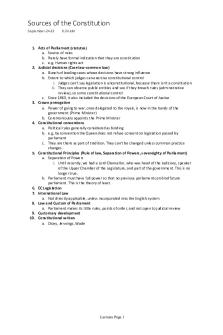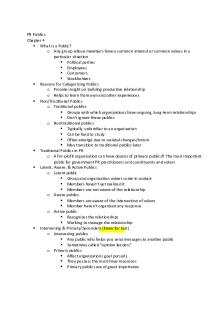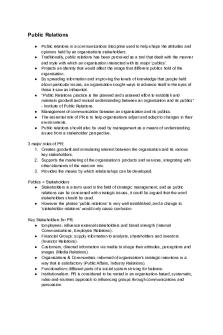Public Relations (PR) - Lecture notes 5 PDF

| Title | Public Relations (PR) - Lecture notes 5 |
|---|---|
| Course | Marketing Communications |
| Institution | Technological University Dublin |
| Pages | 5 |
| File Size | 89.4 KB |
| File Type | |
| Total Downloads | 36 |
| Total Views | 161 |
Summary
Notes which summarise the topic of Public Relations...
Description
Public Relations ● ● ● ●
●
● ● ●
Public relations is a communications discipline used to help shape the attitudes and opinions held by an organisations stakeholders. Traditionally, public relations has been perceived as a tool that dealt with the manner and style with which an organisation interacted with its major ‘publics’. Projects an identity that would affect the image that different publics hold of the organisation. By spreading information and improving the levels of knowledge that people held about particular issues, an organisation sought ways to advance itself in the eyes of those it saw as influential. “Public Relations practice is the planned and sustained effort to establish and maintain goodwill and mutual understanding between an organisation and its publics” - Institute of Public Relations. Management of communication between an organisation and its publics. The essential role of PR is to help organisations adjust and adapt to changes in their environments. Public relations should also be used by management as a means of understanding issues from a stakeholder perspective.
3 major roles of PR: 1. Creates goodwill and stimulating interest between the organisation and its various key stakeholders. 2. Supports the marketing of the organisation’s products and services, integrating with other elements of the marcom mix. 3. Provides the means by which relationships can be developed. Publics = Stakeholders ● Stakeholders is a term used in the field of strategic management, and as public relations can be concerned with strategic issues, it could be argued that the word stakeholders should be used. ● However the phrase ‘public relations’ is very well established, and a change to ‘stakeholder relations’ would only cause confusion. Key Stakeholders for PR: ● Employees; influence external stakeholders and brand strength (Internal Communications, Employee Relations). ● Financial Groups; supply information to analysts, shareholders and investors (Investor Relations). ● Customers; directed information via media to shape their attitudes, perceptions and images (Media Relations). ● Organisations & Communities; informed of organisation’s strategic intentions in a way that is satisfactory (Public Affairs, Industry Relations). ● Functionalism; different parts of a social system striving for balance. ● Institutionalism; PR is considered to be rooted in an organisation-based, systematic, rules-and-routines approach to influencing groups through communications and persuasion.
●
Culture; PR can be considered to be founded on meaning systems adopted by a culture such as cultural values, attitudes and ideas.
Characteristics of PR ● PR does not require the purchase of airtime or space in media vehicles, such as television or magazine. ● Decisions about the transmission of an organisation’s PR messages rests with those charged with managing the media resource. ● Messages that are selected are perceived to be endorsements or the views of parties other than management. ● PR messages usually carry greater perceived credibility than those messages transmitted through paid media, i.e. advertising. ● Due to the degree of trust it generates, it is seen to be an important tool in reducing perceived risk. ● However, management has little control over how the message will be transmitted and perceived. ● The costs of PR are low, especially when compared with advertising. ● PR can be used to reach specific audiences in a way that paid media cannot.
PR Framework The Press Agentry/Publicity Model ● In this approach, communications are used as a form of propaganda. ● The communications flow is essentially one-way, and the content is not bound to be strictly truthful as the objective is to convince the receiver of a new idea or offering. ● Observed in the growing proliferation of media events and press releases. The Public Information Model ● This approach seeks to disseminate truthful information. ● One-way flow, but with little focus on persuasion and more on the provision of information. ● Seen through public health campaigns and government advice communications regarding crime, education and health. The Two-Way Asymmetric Model ● Two way communications is the essence of this approach. ● Feedback from receivers is important, but power is not equally distributed between the various stakeholders which is why the relationship is regarded asymmetric. ● Purpose of influencing attitudes and behaviours via persuasion remains.
The Two-Way Symmetric Model ● The most acceptable and mutually rewarding form of communications. ● Power equally dispersed between the organisation and its stakeholders. ● The flow of communications has an intent to be equally inclusive of all parties. ● The organisation and respective publics are prepared to adjust their attitudes and
●
behaviours in light of the information flow. Emerges a true dialogue, unlike the other three models.
Importance of Relationship Management ● A shift to a relationship management perspective effectively alters the way PR is perceived and practised by organisations. ● It is the ability of organisations to encourage and practise dialogue that really enables truly symmetrical relationships to develop. ● A change in evaluation from measuring the dissemination of messages to one that measures audience influence and behaviour/attitudinal change, and relationship dynamics. ○ A change from measuring outputs to measuring outcomes. ● Traditionally, PR was used as a means of managing communications between parties, but now communications are regarded as a means of managing relationships. ● Organisations should place contact details on all forms of external communications, to enable dialogue. ● Dialogue arising through interaction and the personalisation of communications is important for relationship development.
Objectives of PR ● To provide visibility for the corporate body. ● To support the marketing agenda at the product level. ● To deliver a series of coordinated activities that complement the overall marketing communications strategy and which develop and enhance some of the identity cues used by stakeholders. ● The overall goal should be to develop the relationship that various audiences have with the organisation. ● PR can be used to develop understanding, perceptions and positive attitudes towards the organisation. ● PR can also contribute to the marketing needs of the organisation and will therefore be focused at the product level and on consumers, seeking to change attitudes, preferences and awareness levels with respect to products/services offered.
Cause-related marketing is a commercial activity through which profit-orientated and notfor-profit organisations form partnerships to exploit, for mutual benefit, their association in the name of a particular cause. ● Arises with the need to be perceived as credible, responsible and ethically sound. ● Developing a strong and socially orientated reputation has become a major form of differentiation for organisations operating in various markets, especially where price, quality and tangible attributes are relatively similar. ● Cause-related marketing helps improve corporate reputation, enables product differentiation and appears to contribute to improved customer retention through
enhanced sales. ○ In essence, it is a means by which relationships with stakeholders can be developed.
PR Methods and Techniques ● The range of public relations cues or methods available to organisations is immense. ● Different organisations use different permutations in order that they can communicate effectively with their various stakeholder audiences. ● It is the skill of the public relations practitioner that determines the right blend of techniques.
Cues to build credibility: ● Product quality ● Customer relations ● Community involvement ● Strategic performance ● Employee relations ● Crisis management skills ● Third-party endorsement ● Perceived ethics and environmental awareness Cues to signal visibility ● Sales literature and company publications ● Publicity and media relations ● Speeches and presentations ● Event management ● Marketing communications/messages ● Media mix ● Design (signage, logo, letterhead) ● Exhibitions/seminars; sponsorships
Media Relations ● Consists of a range of activities designed to provide media journalists and editors with information. ● The intention is that they relay the information, through their media, for consumption by their audiences. ● The greater the coverage, the greater the awareness of the organisation, which in turn improves understanding, appreciation and eventually relationship development. ● Audiences perceive much of this information as highly credible simply because opinion formers have bestowed their judgement on the item. ● Various forms of media relations include press releases, interviews, content via press kits, press conferences, and responding to media queries.
Crisis Communications ● Low probability, high impact events ● Can occur from simple managerial mistake, incorrect decision, technology failure, or environmental event. ● Common causes are economic, managerial (human error), political (war, terrorism), climate (natural disasters like tsunami or hurricane), technology (cyber crime), consumer groups (investigations into organisations e.g. greenpeace)....
Similar Free PDFs

Public relations
- 60 Pages

Public relations
- 15 Pages

Public Relations
- 24 Pages

PR - personal relations
- 5 Pages

Public Relations week 1 notes
- 3 Pages

Kampanye Public Relations
- 154 Pages

Public Law - Lecture notes - Public
- 48 Pages

Chapter 4 - Public Relations
- 3 Pages

Sports public relations
- 3 Pages

AMB263 Public Relations A1
- 4 Pages

Public relations theory
- 11 Pages

Professional Public Relations
- 199 Pages

Mastering Public Relations
- 188 Pages
Popular Institutions
- Tinajero National High School - Annex
- Politeknik Caltex Riau
- Yokohama City University
- SGT University
- University of Al-Qadisiyah
- Divine Word College of Vigan
- Techniek College Rotterdam
- Universidade de Santiago
- Universiti Teknologi MARA Cawangan Johor Kampus Pasir Gudang
- Poltekkes Kemenkes Yogyakarta
- Baguio City National High School
- Colegio san marcos
- preparatoria uno
- Centro de Bachillerato Tecnológico Industrial y de Servicios No. 107
- Dalian Maritime University
- Quang Trung Secondary School
- Colegio Tecnológico en Informática
- Corporación Regional de Educación Superior
- Grupo CEDVA
- Dar Al Uloom University
- Centro de Estudios Preuniversitarios de la Universidad Nacional de Ingeniería
- 上智大学
- Aakash International School, Nuna Majara
- San Felipe Neri Catholic School
- Kang Chiao International School - New Taipei City
- Misamis Occidental National High School
- Institución Educativa Escuela Normal Juan Ladrilleros
- Kolehiyo ng Pantukan
- Batanes State College
- Instituto Continental
- Sekolah Menengah Kejuruan Kesehatan Kaltara (Tarakan)
- Colegio de La Inmaculada Concepcion - Cebu


